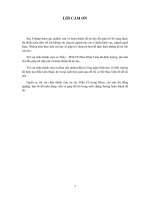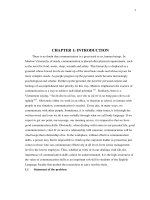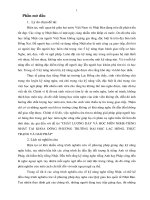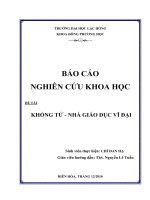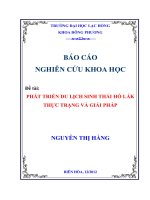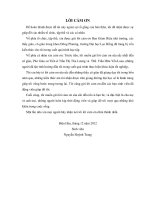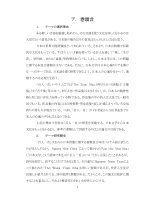Báo cáo nghiên cứu khoa học " Strengthening Capacity in Forest Tree Seed Technologies Serving Research and Development Activities and ex-situ Conservation - MS4 " potx
Bạn đang xem bản rút gọn của tài liệu. Xem và tải ngay bản đầy đủ của tài liệu tại đây (106.69 KB, 14 trang )
Ministry of Agriculture & Rural Development
Strengthening Capacity in Forest Tree Seed
Technologies Serving Research and Development
Activities and ex-situ Conservation
(No. 058/04VIE)
Seed Production Areas :
MS4: Guidelines for Establishment and
Management Practices
by
Khongsak Pinyopusarerk
ensis Genetics
(the joint force of CSIRO and Scion)
Canberra, Australia
August 2005
1 Introduction
The terms ‘seed stand’ and ‘seed production area’ are generally referred to as “A plus
stand that is generally upgraded and opened by removal of undesirable trees and then
cultured for early and abundant seed production”. These two terms are often treated in
different context. In some countries, the term ‘seed stand’ refers to a planted forest
(plantation) which has been converted to produce seed while ‘seed production area’ is a
special area in natural forest which is managed for seed production. In some countries,
however, seed production area is a preferred term for planted forest or plantation which is
managed for seed production. In this guideline ‘seed production area’ is a seed-producing
stand which has been developed either from existing planted stand or from stand
specially planted and managed for seed production purpose.
Organisations with extensive planting programs need large quantities of genetically-
improved seed to increase yield and productivity. There are several methods that can be
used to obtain genetically-improved seed for planting. A simple and relatively low-cost
method to produce slightly-improved seed is development of Seed Production Areas.
Seed production areas are stands specifically managed for seed production. They are
often used as interim sources until a more advanced seed production program such as that
from seed orchards has been established. They are a very effective way of making
available seed supply of an inexpensive but somewhat improved genetic quality.
Although the amount of genetic improvement from a seed production area is expected to
be small, the seed obtained from seed production areas still has better genetic qualities
than seed from commercial collections in routine plantations, especially in adaptability,
form and pest resistance.
2 Seed Production Areas
Seed production areas can be stands specifically planted for seed production or existing
stands specially managed for seed production, provided that their genetic origin is
appropriate.
2.1 Development of seed production areas from existing planted stands
The quickest way to make a seed production area is to convert existing mature stands of
good quality trees for this purpose. A seed production area can also be developed from a
progeny or provenance trial. There are no specific age limitations but the stand should be
old enough to produce seed.
A planted stand suitable for conversion to a seed production area should have the
following specifications.
(1) Details of the seed source used to establish the stand should be known.
2
Knowledge of the geographic origin and genetic base, which ideally will be
broad, is important in determining the suitability of the stand for development into
a seed production area.
(2) The trees should be mature for seed production, but not too old.
There are no age limitations, other than that the stand must be old enough for
reliable selection and be sexually mature to produce seed. Individual trees must
have sufficient crown density to potentially produce large seed crops.
Seeds from very young or very old trees often are of inferior quality compared to
those from middle age trees. In addition, old trees tend not to respond to thinning
by further crown development.
(3) The stand should be near full stocking and contain a large number of trees of good
phenotype.
A suitable stand before conversion should be near full stocking to increase the
selection intensity. The final stocking of a seed production is usually 150-200
stems per ha. An initial survey should reveal that the number of trees of good
phenotypes is equivalent to that.
(4) Free from pests and diseases.
Evidence of pests or diseases may be an indication of inferior adaptability of the
seed source. If the stand shows widespread symptoms of attack by insects or
diseases it should not be used for conversion.
(5) The trees should have proven capacity to produce flowers and seeds in the area.
To avoid failure, a detailed survey of the candidate species’ ability to flower and
seed in a particular environment should be a prerequisite to establishing seed
production area. This is especially important for exotic species where flowering
may fail or seeds are not produced due to incompatibility with the site. Non-
favourable environments, such as drought prone areas, may be unsuitable for seed
production area. Availability of pollinators can also be important.
(6) The area should be easily accessible.
The conversion of a stand into a seed production area and subsequent
management operations, such as harvest of seeds, requires that the area is
accessible throughout the year. This implies that it should be relatively flat but
well drained. Ideally it should not be in a very remote area or too far from
available labour for ease of maintenance and management.
(7) The selected stand should not be subject to commercial harvesting.
3
Seed production areas will be maintained for many years. It is necessary,
therefore, to ensure that the stand in question is safe from commercial harvesting
operations. Good communication with the forest managers will help avoid the
accidental loss of valuable seed production areas.
(8) Size of seed production areas.
In general a minimum of 4 ha is recommended for practical management of seed
production areas for most tree species. Managing small stands is inefficient, and
there is a great danger of contamination from outside pollen. However, for some
species such as eucalypts an area as small as 0.5 ha may be sufficient, due to
prolific seed production. The area should be as close to square as possible, rather
than a long linear block to facilitate more cross pollination among the trees.
(9) Isolation.
Poor isolation will be a common disadvantage of seed production area developed
from existing stands. Usually such stands are selected from mature plantations of
the same species. It is virtually impossible to eliminate completely contamination
by stray pollen. However, an isolation zone or pollen dilution zone surrounding
the seed production area can reduce it. The dilution zone may be an open area of
some 200 m. If trees are to be grown in the dilution zone they must be of a species
that does not hybridise with the species of interest for seed production.
2.2 Development of seed production areas from specially planted stands
When a seed production area is developed from a planted stand established specially for
this purpose, certain factors should be given due consideration.
Site requirements
The environment at the sites where seed production areas are to be established must be
reasonably representative of those where the species are to be planted operationally in the
region, as initial selection will be for superior individuals within such environments. It is
important to select sites that are as uniform as practicable otherwise future management
will be made more difficult.
A check should be made to ensure that the species in question flowers and sets seed
readily in the target environment. Examination of existing stands will establish whether
this is so.
Some specifications, such as the size of seed production area and isolation from pollen
contamination, are the same as that recommended for development of seed production
areas from existing planted stands.
4
Seed source
It should be with seed derived from a large number of unrelated parents of appropriate
provenance or many provenances. Using appropriate provenance(s) ensure the tree will
be more adapted to the plantation site. Improved adaptability alone usually makes seed
collection worthwhile. In most species, certain quality characteristics like stem
straightness, and to some extent branch quality, will also be improved.
Site preparation
The planting site should be cleared of vegetative cover. This will be followed by disc
ploughing of the area prior to planting to give the plants a weed-free start.
Spacing
Planted seed production areas should be established at close spacing. Initial spacing of 3
m x 2 m (1666 stems per ha) is appropriate for most tropical eucalypts. A wider spacing
of 4 m x 2 m (1250 stems per ha) or 3 m x 3 m (1100 stems per ha) is more suitable for
most acacias. Initial high stocking rates allow heavy and early selective thinning so that
the trees of best vigour and form can be retained. At the same time, a wide spacing is
opened up to allow full crowns and good seed crops to develop.
Fertilisation
Application of a starter-dose of balanced fertiliser to aid in successful establishment is
highly recommended. Type of fertiliser and rates of application should where possible be
based on local expertise. Otherwise a complete fertiliser NPK 15:15:15 is recommended
at a rate of 100 g per seedling, in a ring of radius 30 cm around the stem. Fertiliser should
be applied one month after planting.
3 Selection of Trees for a Seed Production Area
Desired attributes of the trees left in a seed production area are similar to, but less
rigorous than, the qualifications required for a select tree to be used in an intensive tree
improvement program. Only trees in the dominant and co-dominant crown classes are
considered for retention because of their growth and seed-producing potential. For
existing mature stands that will be converted, trees showing potential for good seed
production are given preference, although the evidence of past seed production is not
essential if the trees have been growing in a tightly closed stand. Excellent seed crops are
often produced after heavy thinning by trees that showed little seed production prior to
thinning.
Selection criteria may be different between species and end products but the following
characteristics are typical in the case of timber species.
(1) Fast growth
(2) Relatively straight single cylindrical bole
(3) Good crown development
(4) Thin branches with wide branch angle
5
(5) Good self pruning
(6) Free from insects and diseases
No tree below the desired standard should be kept, regardless of spacing. It is essential
that the crowns of the trees be exposed to full sunlight of at least three sides if good seed
production is to be realised. When several good phenotypes occur in a group, enough of
them must be removed so that the remaining trees will receive enough light. In spots
where the only trees available are inferior phenotypes, all trees must be removed, even if
this results in a fairly large gap in the stand.
Selection of trees should be done in small groups for ease of comparison. A group of 16
(4 x 4) trees each is convenient from a practical point of view. By dividing the stand into
small plots, a more even spread of seed trees will be retained after final thinning. Trees
that do not meet the desirable standard are marked for roguing. Colour flagging tapes can
be used for this purpose.
Some species such as casuarinas are dioecious, i.e. trees are unisexual with separate male
and female trees. Care must be taken to ensure that there are sufficient male trees left for
pollination. There is no standard rule regarding the proportion of male and female trees.
A ratio of 30:70 seems reasonable.
The original identity of trees in a seed production area is generally not known. After the
final thinning it is recommended to number all the remaining trees in the stand. This will
provide useful reference to each tree in the future when assessment of flowering and seed
production is required.
4 Thinning Seed Production Areas
Thinning is an essential activity in the development of seed production areas. It removes
poorly-performing individual trees in order to increase the genetic quality of seed
produced by the mating of trees which have been retained. It should be noted that for
some species heavy seed crops may not be obtained for several years after thinning
because of the time required for development of large, vigorous crowns. A final stocking
of 150-200 trees per ha is considered suitable for cross pollination and subsequent seed
production in a wide range of commercial tree species.
Frequency of thinning
Each seed production area should receive at least two-three successive thinnings
(cullings) of poor individuals. Each thinning will selectively remove around 50% of trees.
Opening a stand by thinning will expose trees to risks such as adverse weather
conditions. Desiccation can be a problem in hot humid areas while wind-throw is a
normal problem in strong wind areas. Thinning in several steps, not the total operation at
one time, will allow the remaining trees to adjust and adapt to the new conditions.
Illustration of the thinning process is shown in Figures. 1-6.
6
Timing
The time of thinning should be chosen to avoid potential negative effects. For example,
do not carry out thinning during typhoon season or strong winds as wind-throw and
crown damage can occur. If desiccation is a major risk, carry out thinning just before the
onset of the rainy season.
For seed production areas developed from specially planted stands, the timing will
depend on the growth rates achieved. The aim will be to carry out thinning just before
strong competition between adjacent crowns would otherwise set in (i.e. just before the
crowns touch one another). For many tropical acacias and eucalypts the early rapid
growth rates will necessitate that the first thinning takes place about 24 months of
planting. The second and final thinnings are carried out at 4 and 6 years-of-age
respectively.
Extreme care in conducting thinning operations is important because damage to the
remaining trees can result in a degeneration of their seed production capacities. Careless
thinning is a common cause of later problems in seed production areas.
5 Management of Seed Production Areas
Seed production should be properly managed and maintained to ensure full potential of
seed production capacity.
Removal of cut material
After thinning, it is necessary to remove all cut material that has accumulated on the
ground. Removing the residue allows for easier access into the area for management
activities, and reduces the potential dangers from pests and wildfires.
Weeding
If the seed production area is to function efficiently, vegetative growth under the seed
trees must be controlled. Weed growth can be controlled by regular hand weeding and/or
careful application of herbicides. Trees should not have their growth checked by
competing weeds. Seed production areas will require ongoing weed control throughout
their working life as selective thinning will leave large gaps between trees. Once the trees
attain sufficient height (around 10 m) it may be possible to control weeds by grazing
livestock within the areas.
Control of coppice growth
For strong coppicing species like eucalypts, it is necessary to kill the stumps of cut trees
to discourage regrowth. Glyphosate herbicides, such as Round-up, have proved to be
effective if they are painted or sprayed onto the cut surface immediately after felling.
Multiple applications may be necessary to ensure a 100% kill.
Fertilisation
Fertilisation should be used in conjunction with the opening of the stand by thinning. The
increase in tree vigour resulting from thinning and fertilisation enables the development
7
of heavier and denser crowns that will produce more flowers. N containing fertilisers are
usually applied only to promote vegetative growth. Prior to and during flowering, PK
containing fertilisers with micronutrients should be applied.
Stand demarcation
The external boundaries of the seed production area should be marked with large
permanent markers. A prominent sign should be constructed to explain the purpose of the
stand and the agency responsible for its management.
Protection
Adequate fire breaks (10 m wide or more) should be established surrounding each seed
production area and continually maintained. It may be necessary to fence the area if
foraging domestic stock, wildlife or human activities are likely to cause damage to the
trees.
6 Record Keeping
It is important that full records on all aspects of seed production areas are maintained.
The following information should be included:
• Species
• Seed origin
• Location
• Year of establishment
• Climate (rainfall, temperature)
• Soil
• Silvicultural operations (time of thinning, weeding, fertiliser applications, etc)
• Flowering characteristics
• Annual seed collection (amount of seed, number of trees from which seed is
collected)
It is important to monitor flowering set and seed production as it is influenced by cultural
practices.
7 Seed Harvesting
Prior to seed collection time, a rough inventory should be carried out to determine if
sufficient quantity of seed is available to warrant collection. This can be done by
checking the trees in several small sections within the seed production area. Collection
should not be made if only a small number of trees are found to produce seed. Seed
collected from these trees are likely to be of poor genetic quality because of the limited
cross pollination among the small number of flowering trees. It is also recommended to
avoid seed collection from very early- or late-flowering trees for the same reason.
8
There are various options for seed harvesting. The most common practice is to collect
seed from standing trees in the whole the area, and bulk them up into one seedlot.
Climbers are normally employed to lob branches on the trees. This can be expensive and
should be considered only when there is a high demand for such seed. It should be noted
that if the branches are heavily cut for seed harvesting, it may take a few years before the
crown is fully developed and abundant crop of seed is produced again.
A seed production area can be divided into several sections. Each section is designated
for seed collection in a particular year. By dividing the seed production area into several
sections, the harvested trees will have sufficient time to recover and develop good grown
density when they are revisited again for seed collection. This practice also ensures
continuing supply of seed from the seed production area.
8 Conclusions
Seed production areas have three attributes that are very important.
(1) Seed collected from seed production areas will have better genetic qualities than seed
from commercial collections in routine plantations, especially in adaptability, growth,
stem form and pest and disease resistance.
(2) When seed production areas are developed from stand specially planted for this
purpose, the geographic origins of the parent trees are known, thus producing seed
from a suitable source.
(3) Seed production areas are reliable sources of well-adapted and seed at modest cost.
However, it is emphasised here that seed production areas are interim sources of seed of
somewhat improved genetic quality to meet short-term needs. It is expected that seed
production areas will be obsolete when seed of higher genetic quality of the species of
interest becomes available from seed orchards.
9
SOME TERMS AND DEFINITIONS
Clone: A population of genetically identical individuals obtained by asexual propagation.
Family: Individuals with parents in common.
Half-sib family – One parent in common (mother for trees). Father is unknown,
through natural pollination.
Full-sib family – Both parents in common. Generated by controlled (artificial)
pollination.
Genotype: The genetic potential of the tree when environmental factors are excluded, i.e.
only determined by the genes of the tree.
Inbreeding: Production of offspring by mating between closely related trees, usually by
selfing. This procedure if carried out for a number of generations will expose undesirable,
recessive characters.
Land Race: A population of a species that has developed in a new (“foreign”)
environment through one or more generations.
Ortet: The original plant from which a clone has been derived.
Orthodox seed: Seed that is characterized by small to medium size, often with hard seed
coat, tolerant to desiccation and low temperatures, e.g. acacias, eucalypts, casuarinas,
pines. Conventional storing 5-7% moisture content and 0-5°C temperature. In general
orthodox seed can be stored several decades at 2-4% m.c. and -20°C.
Outcrossing: Production of offspring by mating between unrelated trees or distantly
related trees.
Phenotype: The tree as we see it. Phenotype is determined by the genotype (G) plus the
environment (E), expressed as P = G x E.
Population: A community of interbreeding individuals. No degree of relationship is
assumed.
Progeny: Trees produced from seed of a known parent.
Provenance: The geographic place of origin of a population of seed or plants, or the
population of plants growing at a particular geographic location.
Ramet: An individual member of a clone.
Recalcitrant seed: Seed that is characterised by usually medium to large size, and heavy
due to high moisture contents e.g. Dipterocarpus species, Illicium verum, Artocarpus
(jack fruit). Can not be dried down to low moisture content (5%). Can not be
10
successfully stored at low temperatures for long periods. Tolerant to minimum 20%
moisture content and 12°-15°C for tropical species. Storage period from a few days to
several months.
11
Figure 1. A mature plantation old enough for
conversion to seed production area
Figure 2. Seed production area before first thinning
Thin in groups:
remove poorest
8 out of every
16 trees
Initial stocking:
1250 trees/ha
Selection criteria:
-growth
- stem straightness
- light branching
12
Figure 3. Seed production area - after first
selective thinning
Stocking:
before : 1250 trees/ha
after: : 550 trees/ha
Figure 4. Seed production area - after second
selective thinning
Two selective
thinnings each
removing 50% of
trees
Stocking:
Initial : 1250 stems/ha
After 1
st
thin : 625
After 2
nd
thin 312
Collect seed from remaining, superior, trees after mass
flowering following thinning
13
Figure 5. Seed production area – after third
selective thinning
Three selective
thinnings each
removing 50% of
trees
Stocking:
Initial : 1250 stems/ha
After 1
st
thin : 625
After 2
nd
thin 312
After 3
rd
thin 150
Collect seed from remaining, superior, trees after mass
flowering following thinning
Figure 6. General view of a seed production
area after thinning was completed
14
